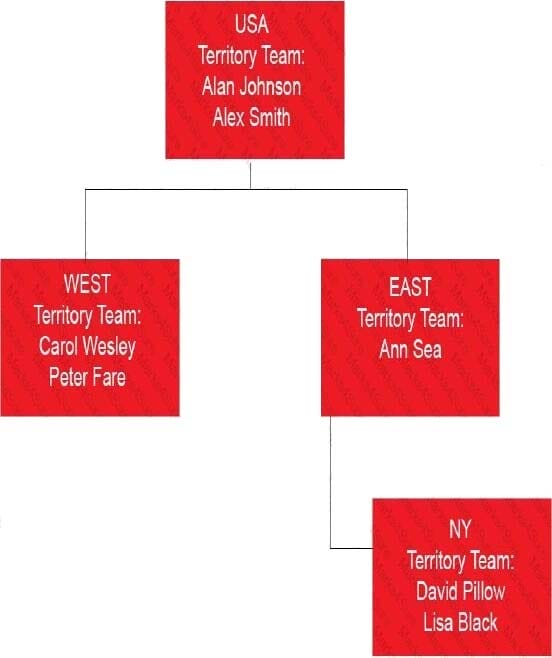Exam Details
Exam Code
:1Z0-970Exam Name
:Oracle Sales Cloud 2017 Implementation EssentialsCertification
:Oracle CertificationsVendor
:OracleTotal Questions
:75 Q&AsLast Updated
:Mar 29, 2025
Oracle Oracle Certifications 1Z0-970 Questions & Answers
-
Question 31:
Which three statements are true with respect to an internal territory and a partner territory? (Choose three.)
A. A partner territory is the jurisdiction of the reselling partner and contains partner resources.
B. You cannot assign specific partner territories to an account that contains only partner resources.
C. Salesperson territory is the area of responsibility of a sales representative over a set of accounts, leads, and opportunities.
D. Internal territories can only have internal resources assigned, while partner territories are controlled by the partner organization.
-
Question 32:
Consider the following:

An opportunity is associated with the NY Territory.
Mike Lee and Susan Brown are members of the opportunity sales team.
Mark Lake is Susan Brown's manager.
Which option shows the members of the sales team who can view the opportunity record?
A. Mike, Susan, Mark, David, Lisa, Ann, Alan, and Alex
B. Mike, Susan, David, and Lisa
C. Mike, Susan, Mark, David, Lisa, and Ann
D. Mike, Susan, David, Lisa, Ann, Carol, and Peter
E. Mike, Susan, David, Lisa, Ann, Alan, and Alex
-
Question 33:
Which Setup and Maintenance task is used to run imports in Oracle Sales Cloud?
A. Run File Imports
B. Manage File Import Activities
C. Schedule File Import Activities
D. Manage File Importing
-
Question 34:
You made some changes to the mapping for converting leads to an opportunity, but you missed mapping the entity "Opportunity Team Member". What happens?
A. The opportunity is created but is not visible to users.
B. The opportunity is created, but only the primary member of the sales team is copied to the opportunity.
C. The opportunity is created with an empty sales team.
D. The lead conversion fails with a mapping error.
E. The lead conversion procedure ends with a timeout error because of a loop reference.
-
Question 35:
Which profile option needs to be enabled for the use of auxiliary dimensions in territory definition?
A. There is no need to set any profile option
B. Customer Type for auxiliary dimension needs to be set to Customer Type
C. Customer Account for auxiliary dimension needs to be set to Customer Type
D. Customer Class for auxiliary dimension needs to be set to Customer Class
E. Classification Category for auxiliary dimension needs to be set to Classification Category
-
Question 36:
Which two updates are typically performed on a quarterly basis? (Choose two.)
A. Oracle optional updates
B. Infrastructure updates to the database and hardware
C. National Language Support updates to support language packs
D. Oracle mandatory updates
E. Vertex updates to update U.S. and Canadian tax rates and address validations
-
Question 37:
Your customer wants to track the change history of the Opportunity business object. After setting the audit level of the Sales Cloud Application to "Auditing", you still cannot see any audit log.
Which configuration step must be completed to achieve this requirement?
A. Defining the logging path
B. Defining the users that are going to be audited
C. Selecting the Opportunity business object and the attributes that you want to log
D. Setting the log event level to 5
E. Selecting the events that you want to log
-
Question 38:
In the Desktop User Interface (Desktop UI), how would you configure the regional area of the Customer Center for all users?
A. Right-click within the Navigator panel to modify the regional UI.
B. Access an Account record and click the Manage Customer Tree action.
C. Use the Functional Setup Manager Task of Manage Customer Tree.
D. It is not possible to configure the Customer Tree for all users.
-
Question 39:
Which four key attributes can you configure to reference customers in Oracle Sales Cloud? (Choose four.)
A. Reference association with Lead: In the references UI, the Lead tab displays all Leads where the reference customer was used.
B. Reference association with Opportunity: In the references UI, the Opportunity tab displays all Opportunities where the reference customer was used.
C. Collateral: Associates collateral with reference customers to give salespeople materials to help them make sales.
D. References profile: Stores and maintains the reference customer profile, which also displays some underlying party-specific attributes and lists the deals the reference has already participated in.
E. Status: Indicates whether or not the customer is an active reference.
F. Rank: Designates the internal ranking of the customer, such as 1, 2, or 3.
-
Question 40:
Identify three mandatory items for creating a rule set in Oracle Sales Cloud. (Choose three.)
A. Name
B. Effective Start Date and Effective End Date
C. Work Object
D. Business Object
E. Candidate Object
Related Exams:
1Z0-020
Oracle8i: New Features for Administrators1Z0-023
Architecture and Administration1Z0-024
Performance Tuning1Z0-025
Backup and Recovery1Z0-026
Network Administration1Z0-034
Upgrade Oracle9i/10g OCA to Oracle Database OCP1Z0-036
Managing Oracle9i on Linux1Z0-041
Oracle Database 10g: DBA Assessment1Z0-052
Oracle Database 11g: Administration Workshop I1Z0-053
Oracle Database 11g: Administration II
Tips on How to Prepare for the Exams
Nowadays, the certification exams become more and more important and required by more and more enterprises when applying for a job. But how to prepare for the exam effectively? How to prepare for the exam in a short time with less efforts? How to get a ideal result and how to find the most reliable resources? Here on Vcedump.com, you will find all the answers. Vcedump.com provide not only Oracle exam questions, answers and explanations but also complete assistance on your exam preparation and certification application. If you are confused on your 1Z0-970 exam preparations and Oracle certification application, do not hesitate to visit our Vcedump.com to find your solutions here.